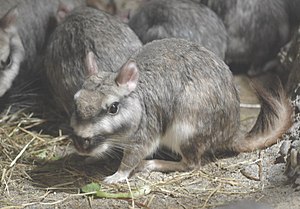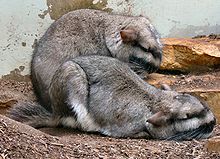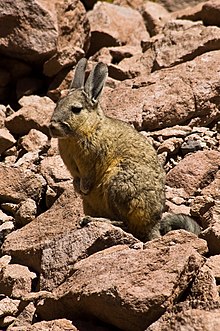Viscacha
| Viscacha | ||||||||||||
|---|---|---|---|---|---|---|---|---|---|---|---|---|

Viscacha ( Lagostomus maximus ) |
||||||||||||
| Systematics | ||||||||||||
|
||||||||||||
| Scientific name of the genus | ||||||||||||
| Lagostomus | ||||||||||||
| Brookes , 1828 | ||||||||||||
| Scientific name of the species | ||||||||||||
| Lagostomus maximus | ||||||||||||
| ( Desmarest , 1833) |
The Viscacha or the Viscacha ( Lagostomus maximus ), in contrast to the rabbit mice or mountain viscachas, also called plain Viscacha, is a rodent species from the chinchillas family (Chinchillidae). There are animals living in South America with a weight of up to 8 kilograms, which inhabit underground burrows in groups.
features
Viscachas are sturdy animals with a massive head. They reach a head body length of 47 to 66 centimeters, plus a 15 to 20 centimeter long tail. At 2 to 4.5 kilograms, the females are significantly lighter than the males, who weigh 5 to 8 kilograms. The fur color varies on the upper side with the habitat from light brown in sandy regions to dark gray, the belly is white. The undercoat is very soft, the top hair, however, dark and rough. The front legs are short and end in four flexible toes; the hind legs are longer and very muscular, they each have three toes equipped with powerful claws.
The massive head is characterized by two striking black horizontal stripes, the upper one over the eyes and the lower one over the nose. The area in between is colored white, as are the cheeks and a short stripe above each eye, a streaked face is unusual in rodents. The tooth formula is like all guinea pig relatives I 1- C 0- P 1- M 3, so a total of 20 teeth. As in all rodents , the incisors are transformed into rootless incisor teeth , the molars , as in all chinchillas, are also rootless .
Viscachas are one of the rodents with the most noticeable sexual dimorphism .
distribution and habitat
Viscachas live in the grasslands of southern South America . Their distribution area includes the south of Bolivia , the west of Paraguay and the northern and central regions of Argentina .
Way of life
Viscachabaue
Viscachas live in groups in large underground, self-dug burrows. They dig with their front paws and push the earth either with their hind legs backwards or with their nose up - the nasal mirror (rhinarium) is hairy and folded - to prevent soil from penetrating into the nose. Viscachabaue ( vizcachera in Spanish ) are very large and complex and consist of numerous tunnels, chambers and cross connections. The structures can cover an area of 600 square meters and have up to 30 entrances. The entrances are marked with sticks, bones, stones, dried cow dung or the like.
Viscachabaue also serve as a habitat for other animals, for example insects, toads, lizards, snakes or skunks. Three species of birds are known to breed in it: the rabbit owl , the Patagonian chopper ( Geositta cunicularia ) and the black- tipped swallow ( Notiochelidon cyanoleuca ). Also Pampa foxes and boa sometimes live in the building and hunt the animals.
Social and territorial behavior
Viscachas have distinctive social behavior. They live together in groups of 15 to 30 animals, which consist of one to three males, several females and their offspring. Viscacha groups are dominated by the females, who stay in their burrow throughout their lives and establish a matriarchal hierarchy.
After the mating season, the males often leave the group voluntarily or are driven away by competitors. Especially at the time of the birth of the young animals, the males are removed from the main building and live in remote "satellite buildings" at this time. During the mating season, the males try to find their way back into the group, but they are usually not the same males as before. The males often fight fierce battles among themselves for access to the burrow. Almost all males bear scars from these fights. Occasionally there are also deaths. However, once a few males have nested in the burrow, they live peacefully side by side.
One group lives in an area of around 1 to 4 hectares. The males mark the territory with urine or the secretion of scent glands on the face. The borders of the territory are not defended, but animals from outside the group are vehemently chased away from the building entrances.
Activity times and movement
Viscachas are nocturnal and leave the burrow in the evening. After a short period of grooming and rolling in the dust, they go in search of food. The residents of a building often split into several groups; except in winter, the males are mostly traveling alone. The composition of these foraging groups is flexible and can change several times in one night. Sometimes the animals rest outside the burrow or return briefly there.
When threatened, a male emits a warning call, which is sometimes repeated by other animals or even by neighboring groups from other burrows. Then the animals try to run back into their den. They can reach a speed of 40 kilometers per hour or they try to shake off the attacker with up to 3 meters wide jumps and sharp hooks.
With the nocturnal way of life, they escape the summer heat of the day.
nutrition
Their food is purely vegetable and consists mainly of seeds and grasses. Investigations have shown that parts of the dwarf snail ( Medicago minima ) and the common heron's beak ( Erodium cicutarium ) in particular are ingested. However, if necessary, they also consume any type of vegetation. The food is always consumed on the spot and not stored in the building.
Reproduction

In the warmer north of their range, the females can have two litters a year. Reproduction can take place all year round. In the south (e.g. in central Argentina) there is a fixed mating season between March and May and only one litter per year.
The physiology of reproduction is unique. There is a Hyperovulation , the simultaneous ripening of 200 to 800 eggs . After a delay in implantation of up to 18 days, up to five blastocysts implant in each horn of the paired uterus ; but all but the outermost embryos are reabsorbed.
After a gestation period of around 154 days (including the 18 days delayed implantation), the female gives birth to one to four (on average two) young. The newborns flee the nest , are relatively large (around 200 grams) and hairy. The young animals are weaned after three weeks at the earliest, but usually only after several weeks. Females reach sexual maturity at seven to eight months, males at around 15 months. The highest known age of a Viscacha in human care was nine years.
Viscachas and people
Viscachas are considered a plague because their burrows often devastate the fields and the grazing cattle occasionally break into them and injure their legs as a result. In Argentina , their meat is often eaten, for the use of fur → Viscachafell . The transformation of their living space into agriculturally used areas poses a threat.
Viscachas have disappeared from part of their area of distribution, especially from the intensely agricultural regions of Argentina. Overall, however, the species is not one of the endangered species.
Flatland Viscachas have only been kept in Schönebeck in Germany since they were no longer kept in Stuttgart in 2015 . The Zurich Zoo is extremely successful in keeping and breeding of animals.
Systematics

The Viscacha forms with the four kinds of the rabbit mice or mountain viscachas ( Lagidium ) and the two kinds of the real chinchillas ( Chinchilla ) the family of the chinchillas (Chinchillidae) within the rodents. Despite their name, the mountain viscachas are more closely related to the actual chinchillas than to the (flatland) viscachas.
Three subspecies are distinguished within the Viscacha: Lagostomus maximus immolis in the north, L. m. maximus in the middle part and L. m. petilidens in the south of the distribution area. The subspecies differ in terms of coat color and skull structure, but the exact distribution limits are not known.
In 1910 a second, but extinct Viscachart with the scientific name Lagostomus crassus was described based on a skull find from Peru . The site is over 1000 kilometers north of the northernmost distribution area of the Viscachas, the skull was not yet fossilized, so it must have been relatively recent. The size of the skull resembles that of the Viscacha, otherwise there is no evidence of this mysterious species. John Jackson et al. (1996) think it is conceivable that it could simply have been a Viscacha brought to Peru; Wilson and Reeder (2005), however, recognize L. crassus as a separate species.
literature
- John E. Jackson, Lyn C. Branch, and Diego Villarreal: Lagostomus maximus. In: Mammalian Species . No. 543, 1996, pp. 1-6, online (PDF; 759 KB) .
- Ronald M. Nowak: Walker's Mammals of the World. 2 volumes. 6th edition. Johns Hopkins University Press, Baltimore MD u. a. 1999, ISBN 0-8018-5789-9 .
- Don E. Wilson , DeeAnn M. Reeder (Eds.): Mammal Species of the World. A taxonomic and geographic Reference. 2 volumes. 3. Edition. Johns Hopkins University Press, Baltimore MD 2005, ISBN 0-8018-8221-4 .
Web links
- Lagostomus maximus in the endangered Red List species the IUCN 2007. Posted by: O. Pearson, 1996. Accessed on March 17 of 2008.
Individual evidence
- ↑ http://www.zootierliste.de/ . Retrieved May 12, 2015.
